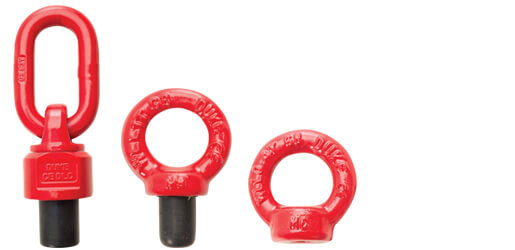Lifting Eyes - Eye Bolts and Eye Nuts
Lifting Eyes in High Tensile Steel Alloy, Tested and Certified for Industrial Applications
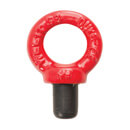
|
|
Lifting Eye Bolt - Grade 80
|
|
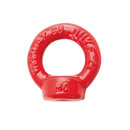
|
|
Lifting Eye Nut - Grade 80
|
|
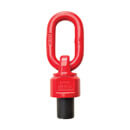
|
|
Swivel Lifting Eye Bolt - Grade 80
|
|
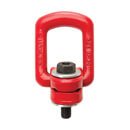
|
|
Pivot Lifting Eye Bolt - Grade 80
|
|

|
|
Lifting Eye Bolt - Grade 80
|
|

|
|
Lifting Eye Nut - Grade 80
|
|

|
|
Swivel Lifting Eye Bolt - Grade 80
|
|

|
|
Pivot Lifting Eye Bolt - Grade 80
|
|
Eye bolts and eye nuts are commonly used to assist with Lifting Heavy Loads, and can be used as a lifting or securement point allowing you to securely attach ropes and cables to a larger structure.
Grade 80 eye bolts and eye nuts are manufactured from high tensile alloy steel and individually magnaflux crack detected after heat treatment.
All lifting eyes are proof tested to 2.5 times the working load limit.
Always select the correct eye bolt based on its type and capacity for the lift you are conducting.
Lifting eyes with a shoulder feature provides more stability to the base of the eye and therefore shoulder eye bolts are suitable for vertical or angle loading. Be aware that lifting eye bolts at an angle reduces the working load limit.
We recommend only using Grade 80 lifting eyes with Grade 80 components.
Each Eye Bolt is supplied with the relevant certification.
Safe Use of Lifting Eyes
Before Use:
- Store and handle eye bolts correctly.
- Inspect eye bolts before use and before placing into storage.
- Select the correct pattern eye bolt for the application.
- Ensure that the eye bolt and tapped hole threads are compatible and strong enough for the load.
- Correctly align the plane of the eye using shims where necessary.
- Ensure that the collar is fully seated when hand tight.
Do Not:
- Never run a sling through a pair of eye bolts: this will reduce the effective angle of lift and will put more strain on the rigging.
- Never force the slings through eye bolts. This force may alter the load and the angle of loading.
- Never use eye bolts that have been ground, machined or stamped.
- Never use bars, grips or wrenches to tighten eye bolts.
- Never paint an eye bolt. The paint could cover up flaws.
- Never force hooks or other fittings into the eye; they must fit freely.
- Never shock load eye bolts.
- Never use a single eye bolt to lift a load that is free to rotate.
- Never use eye bolts that have worn threads or other flaws.
- Never insert the point of a hook in an eye bolt. Use a shackle.
Storing Lifting Eyes:
- Always keep eye bolts clean, protect from corrosion and protect threads from damage.
- Never attempt to straighten bent eye bolts or re-cut threads.
- Regularly inspect eye bolts and, in the event of the following defects, refer the eye bolt to a Competent Person for thorough examination: illegible markings; distortion; worn, or bent shanks and threads; incomplete or incorrectly formed threads; damaged eyes; nicks, gouges, cracks, corrosion or other defects.
